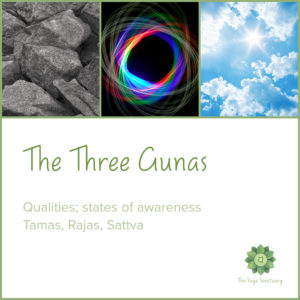 The word Guna means “that which binds” in Sanskrit. According to Vedic science, all matter and energy that make up the manifest world consists of the three gunas in different quantities. They describe the qualities of nature and states of awareness, and are likened to strands, that when woven together, form the rope of Maya or illusion.
The word Guna means “that which binds” in Sanskrit. According to Vedic science, all matter and energy that make up the manifest world consists of the three gunas in different quantities. They describe the qualities of nature and states of awareness, and are likened to strands, that when woven together, form the rope of Maya or illusion.
Tamas provides the stability of physical forms and the physical body. Its direction is downward. It is heavy and maintains inertia, particularly for solid objects at rest. Mentally, tamas binds through attachment and can be seen in our tendency to cling to situations. The tortoise has a preponderance of tamas. Potential energy corresponds to tamas and excess leads to ignorance and delusion.
Rajas expresses itself through activity and desire, in a side to side fashion. It gets us moving as a result of need and preference. Mentally, rajas binds through the desire for pleasure, changing emotions, and emphasis on others. Worldly pursuits are mainly rajasic in nature. Kinetic energy corresponds to rajas and excess leads to exhaustion of all kinds.
Sattva looks after growth, love and the higher mind. Its direction is upward. It is responsible for equilibrium, harmony, peace and knowledge. Spiritual practices aim to cultivate sattva, binding us to wisdom, which is the bond that breaks all other bonds. Sattva dominates in scripture, for example, although excess can lead to a disruption of worldly duties for the householder.
Each guna has a necessary and proper function. The true Self exists beneath their attributes.
